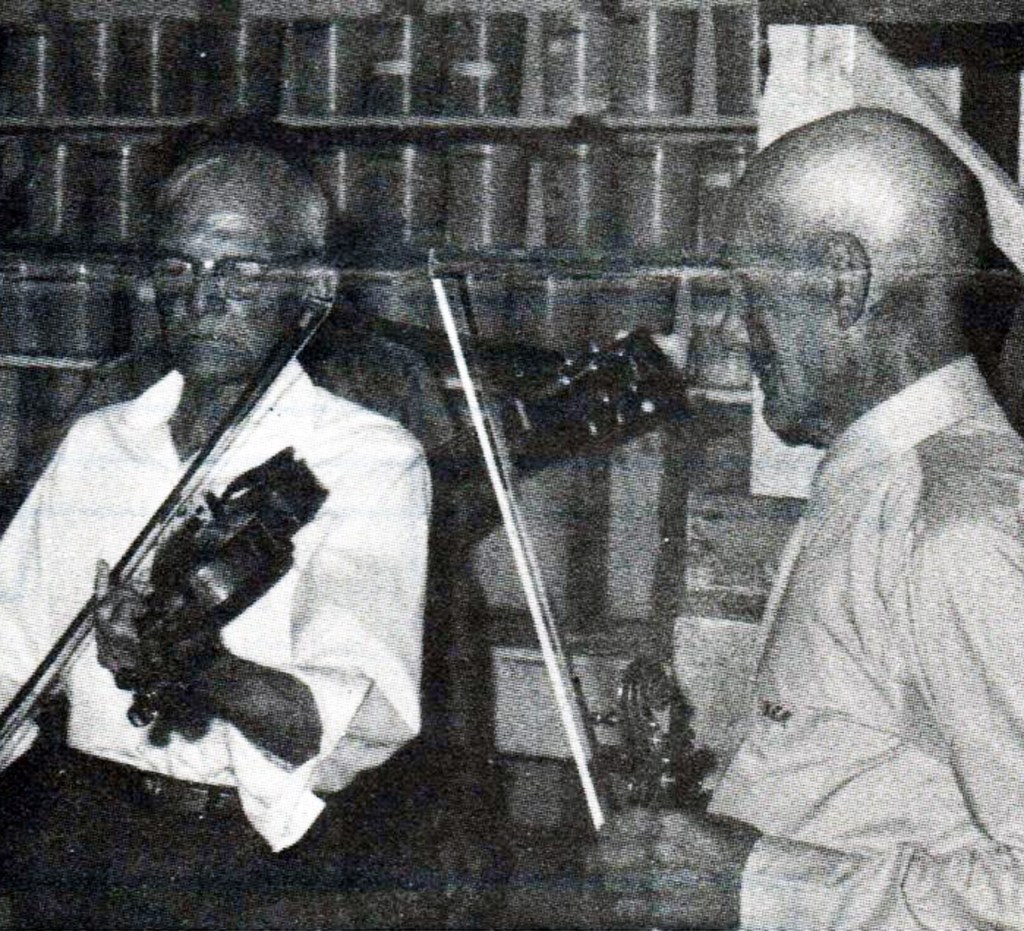Discovery, Archaeology and Fiddling: Paisley Hagood – When to start and when to quit
Published 4:21 pm Monday, September 19, 2011

- Paisley Hagood smoothes out a finger buster as Sam McCracken roots him on.
James Paisley Hagood (1905- 1977) was a wage-earning farmer and fiddler in the Southwestern part of the county. With a son-in-law who also enjoyed good old-time music, Paisley was encouraged to rediscover the fiddle after a long spell of not even owning one.
My mother Nancy Hagood Holland, said her father Paisley (pronounced pace-lee) surprised her and her sister Annie Ruth Hagood Smith by taking up fiddling after her beau and soon-to-be husband Bob Holland got intrigued during his visits to their house. Paisley had fiddled a good bit in his youth, but fell away from fiddling while raising his daughters with his wife Mrs. Sue Ball Hagood. As they would discover, Paisley had retained quite an impressive ability to fiddle, and many tunes and tales from those earliest fiddlers conventions in the county.
He often cited John Chambers (1856-1937), (see part 2) as an influence, as being one of the counties best fiddlers — a source for tunes and style. He was attracted to the “Chambers lick,” a particular style involving longer bow strokes, and smooth connected notes. Some of Paisley’s tunes predate the Civil War, and were slave tunes and banjo tunes he would add. It was common for fiddle and banjo tunes to return home with soldiers on leave or after the Civil War. An example is one of his tunes, “Old Abbott.” It does follow the structure of an old banjo tune with its short phrases and stingy range. It resembles a very old fiddle tune popular in the upper South, titled “Callahan.” Another variant of this tune family was collected in Kentucky by fiddler Bruce Greene and titled “McClannahan’s March.”
Paisley learned the old tunes in the old way from other fiddlers playing both lilting tunes for dances, and also listening pieces. One peculiarity included starting tunes without warning and finishing without warning. Modern musicians are accustomed to elaborate intros and outros, but the old fiddlers had less need for that. They were fiddling, not performing so to speak. The fiddler knows when to start, and when to quit.
He held his fiddle on his chest most times, and still managed the full faculty of all four fingers. His bow still shows evidence of a forward grip, which would draw the curiosity of modern violin teachers. Both habits were believed to be poor form during the 20th century, but were standard practice prior to the 19th century, as evidenced in numerous period paintings, sketches, and writings. Paganini was depicted with his fiddle on his chest, and his bow held “up high.” Modern violinists pursuing baroque music such as Vivaldi, Bach and Handel are re-discovering the merits of the old ways and the old sound. In contrast to other forms of violin music, fiddling seems to be a tradition passed on aurally from those earliest years, in person from fiddler to fiddler, from Ireland, to Scandinavia, to Eastern Europe to the Southeastern U.S.
Paisley was a bit nervous about attention, and disliked being recorded, “Ahh, I cain’t fiddle with that thing a-runnin’, see there?” Ed McCracken, son of Sam McCracken (see part 3), once shared a story about attending a convention in Jackson County, one very cold evening. Worried his fiddle would go out of tune, Paisley snuggled it under his coat. Startled when they call his name to the stage, he dropped his fiddle! Ed supportively lent him his own fiddle and encouraged him to go on anyway. He ended up winning! He had won other contests in his youth, and was at the first fiddlers conventions held at Pleasant Point School, hollering distance from his front porch on New Cut Road.
Paisley’s father John Hagood was also a fiddler. He had several archaic tunes he played, some in an old tuning of “A.” Paisley described this tuning as “A” or “High Bass and Counter” by “runnin’ those two strings up”, referring to the D and G strings re-tuned to E and A. This tuning gives the fiddle a full, droning sound. Many violinists don’t realize there are many tunings for fiddles. Hardingfele, or hardanger fiddle music of Norway utilizes as many at 17 different tunings dating to the mid-17th century.
Paisley could play with a rocking bow and used nice string crossings reminiscent of the great Fiddlin’ Arthur Smith, who was discovered by Limestone County’s own Delmore Brothers. But Smith’s hot rolling sound was hard for a developed old-time fiddler to attain, starting a new style becoming the incubus of bluegrass fiddling. Paisley remained true to an older sound, “I can’t do much with it (the fiddle), just making a mess of it.” His phrasing was contagious, and a direct result of a disciplined shuffle system, most likely intuitive, less likely intentional.
Jerry McGlocklin shared that Paisley was a great old-time fiddler, but just didn’t know it. With a strong draw and tone particularly in G on the low strings, he would find ways to wedge yet another note in where you wouldn’t think possible, Jerry marvels. Knowing he was going to have to leave his fiddle behind one day, he purchased a second fiddle from Jerry, so each daughter would have one. Grandaddy spent those last years perfecting his tunes, never satisfied with them, until it came time to proverbially hang up the fiddle, loosen the bow, and let someone new have a try at the old tunes.
Jim Holland is a regular at regional and national conventions and competitions as well as recent instructional opportunities at the Alabama Folk School, the Chattanooga Folk School and other regional workshops. Jim invites those interested in old-time music to contact him at his Athens home at 256-771-0242 or by email at jhol111964@sprintmail.com.


